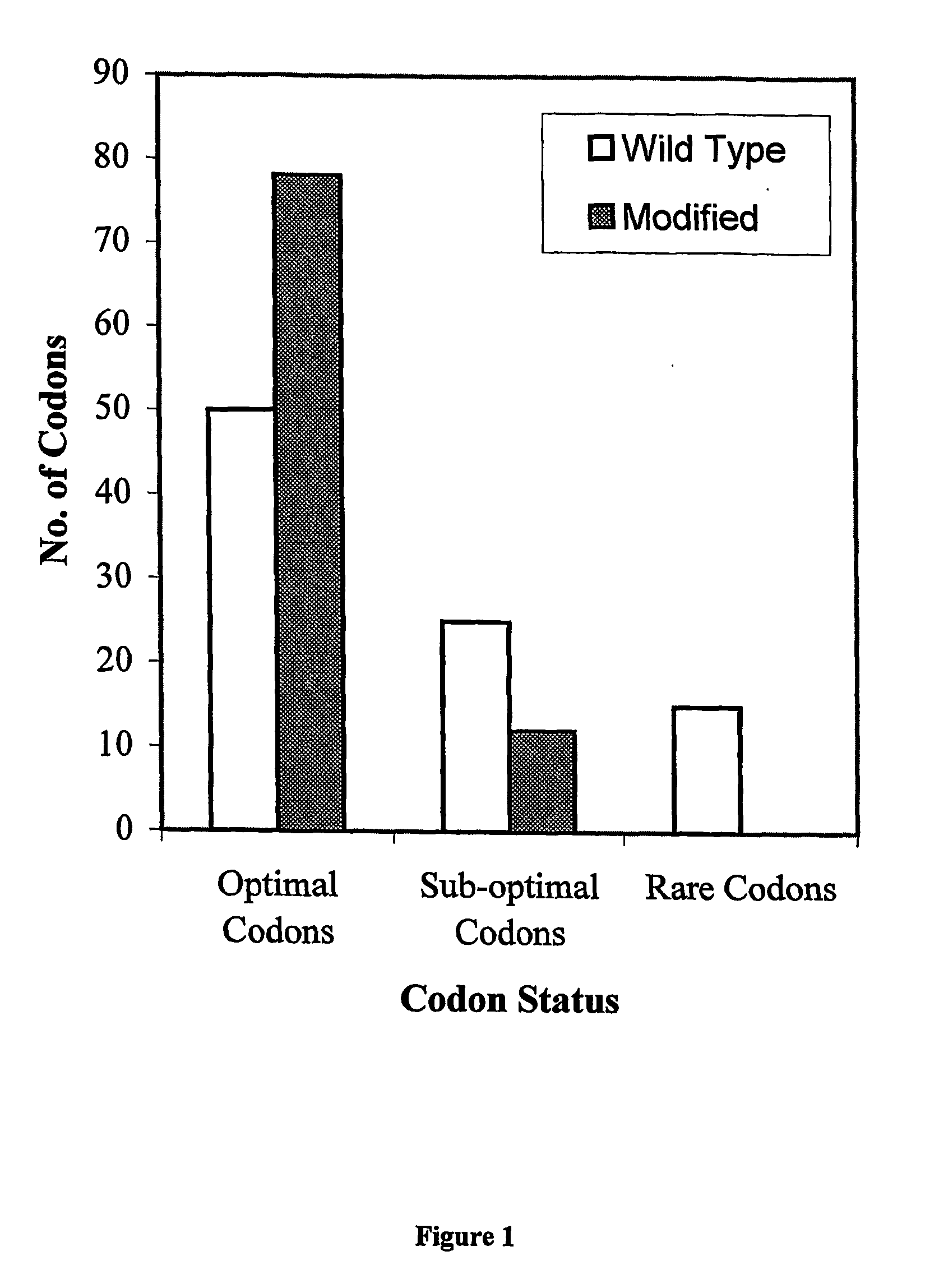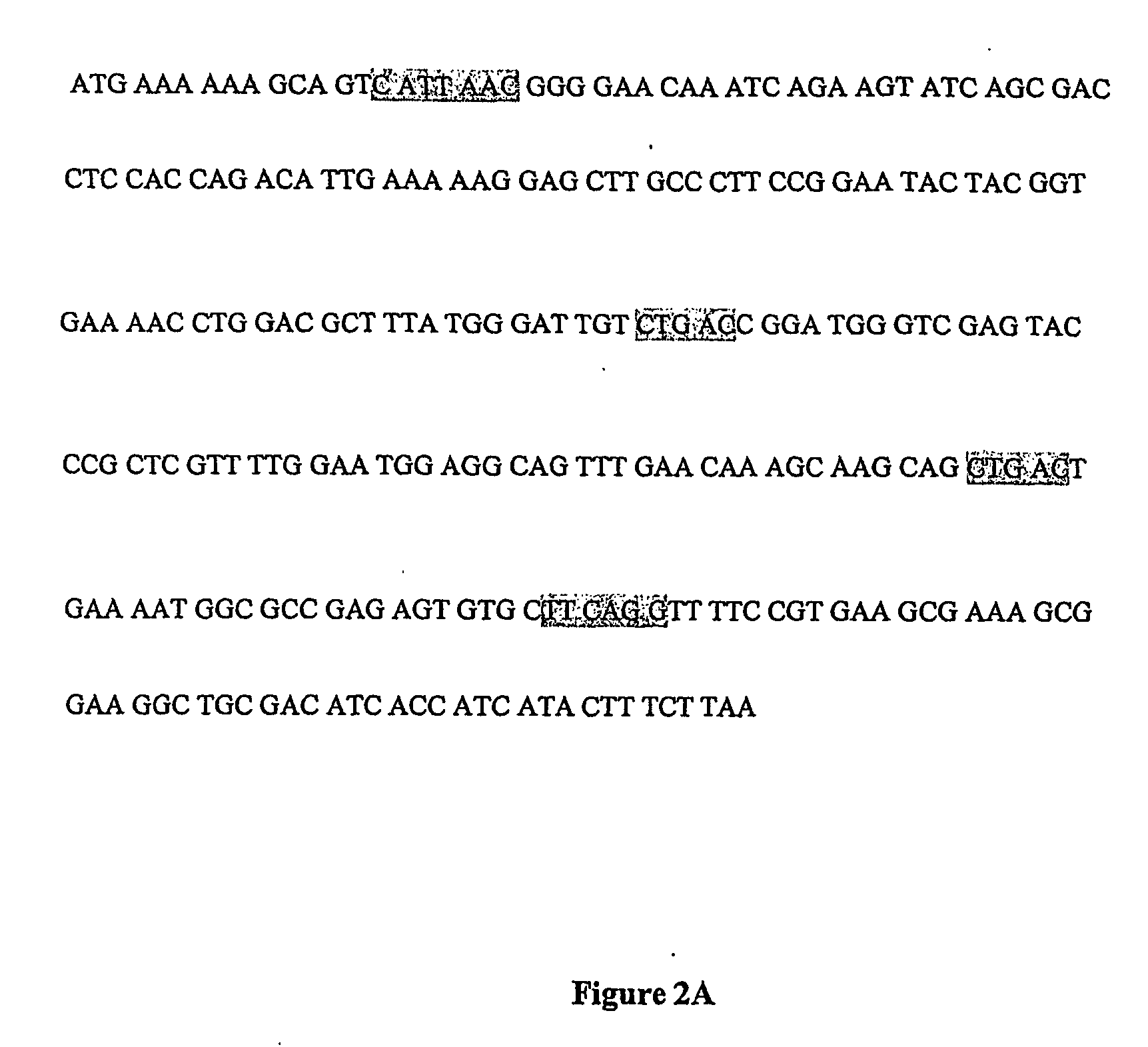Method for obtaining improved fertility restorer lines for transgenic male sterile crop plants and a dna construct for use in said method
- Summary
- Abstract
- Description
- Claims
- Application Information
AI Technical Summary
Benefits of technology
Problems solved by technology
Method used
Image
Examples
example 1
Construction of Modified Barstar Gene:
[0122] The 273 bp modified sequence of the barstar gene was constructed by Recursive PCR (Dillon and Rosen 1990, Biotechniques 9:298-299). The modified sequence was assembled in a first PCR reaction (ICR-I) using four long oligos (L1-L4; with an overlap of 20 bp between adjacent oligos) followed by amplification in a second PCR (PCR-II) of the assembled sequence using two shorter, flanking primers (S1 and S2). Sequences of the oligos and primers used are given below.
Oligo L1:(Seq. ID #5)5′-ATG AAG AAG GCT GTG ATC AAT GGA GAA CAA ATC AGATCT ATC TCA GAC CTT CAT CAA ACT TTG AAG AAG GAGCTT GCT CTT CCT G-3′Oligo L2:(Seq. ID #6)5′-AAG AGG GTA CTC AAC CCA TCC AGT AAG ACA ATC CCACAA AGC GTC CAA GTT CTC ACC ATA GTA CTC AGG AAGAGC AAG CTC CTT C-3′Oligo L3:(Seq. ID #7)5′-GGA TGG GTT GAG TAC CCT CTT GTT TTG GAA TGG AGGCAA TTC GAG CAA TCT AAG CAA CTT ACT GAG AAT GGAGCT GAG AGC GTT CT-3′Oligo L4:(Seq. ID #8)5′-TTA AGA AAG AAT GAT AGT GAT GTC ACA TCC TTC A...
example 2
Development of DNA Constructs:
[0129] The wild type and modified sequences of the barstar gene were PCR amplified using the following primers to incorporate the restriction sites BspHI and XbaI at their 5′ and 3′ ends respectively to facilitate further sub-clonings.
[0130] Primers for the wild type barstar gene:
(Seq. ID #15)FP:5′-CCT CAT GAA AAA AGC AGT CAT TAA C-3′ BspHI(Seq. ID #16)RP:5′-GGT CTA GAT TAA GAA AGT ATG ATG GT-3′ XbaI
[0131] Primers for the modified barstar gene:
(Seq. ID #17)FP:5′-CCT CAT GAA GAA GGC TGT GAT CAA-3′ BspHI(Seq. ID #18)RP:5′-CTA GTC TAG ATT AAG AAA GAA TGA TAG TG-3′ XbaI
[0132] Following amplification, the PCR products were cloned in pCR Script SK+ at the SrfI site to generate the plasmids pCR Script SK+ barstar(wt) and pCR Script SK+ barstar(mod) and sequenced to verify the fidelity of amplification.
Development of Construct I:
[0133] a) The bar gene, used as a plant selectable marker, was fused at its 5′ end with the CaMV35S doub...
example 3
Seed Sterilization and Germination:
[0144] Seeds were surface sterilized by treatment in diluted Teepol solution (laboratory grade surfactant) for 10 minutes followed by washing under running water for 30 minutes. Seeds were subsequently treated with 70% ethanol for two minutes under sterile conditions and rinsed twice with sterile distilled water. Further, seeds were treated with 0.05% mercuric chloride for 10 minutes followed by a treatment with 1% sodium hypochlorite for 9 minutes. Following each treatment, seeds were rinsed thoroughly with sterile distilled water. Surface sterilized seeds were germinated on hormone-free full strength MS medium (Murashige and Skoog 1962, Physiol. Plant. 15:473-493). Seeds were germinated in glass tubes covered with a cotton plug with four seeds in each tube. The seeds were kept in dark for two days and then maintained under light (Philips cool-white fluorescent lamps, 20001 ux, 16-h light / 8-h dark cycle). Temperature in the culture room was main...
PUM
| Property | Measurement | Unit |
|---|---|---|
| Fraction | aaaaa | aaaaa |
| Fraction | aaaaa | aaaaa |
| Electrical resistance | aaaaa | aaaaa |
Abstract
Description
Claims
Application Information
 Login to View More
Login to View More - R&D
- Intellectual Property
- Life Sciences
- Materials
- Tech Scout
- Unparalleled Data Quality
- Higher Quality Content
- 60% Fewer Hallucinations
Browse by: Latest US Patents, China's latest patents, Technical Efficacy Thesaurus, Application Domain, Technology Topic, Popular Technical Reports.
© 2025 PatSnap. All rights reserved.Legal|Privacy policy|Modern Slavery Act Transparency Statement|Sitemap|About US| Contact US: help@patsnap.com



